
King Charles III is only a month into his reign but the laws that governed his accession to the throne, and the succession for the House of Windsor, date back centuries.
Today’s succession laws can be traced back to two documents: the Bill of Rights of 1689 and the Act of Settlement of 1701. Through these documents, the Stuart dynasty and the Hanoverian dynasty cemented their rule, leading to the modern-day House of Windsor.
The Bill of Rights of 1689 was created after the Glorious Revolution and determined that King James II had abdicated his throne when he fled the country. He was therefore replaced by his daughter Mary II and her husband, William III, who reigned jointly. When William died in 1702, Mary’s younger sister Anne became Queen of England.
Queen Anne was pregnant many times throughout her life but none of her children survived childhood, and she was the last of the Protestant Stuarts. The Bill of Rights of 1689 only accounted for the Protestant descendants of Mary, William, and Anne—the document ended with Anne’s succession; and it was likely considered that she would have heirs, if Mary and William did not produce heirs of their own.
In 1701, the Act of Settlement was passed to shore up the line of succession past Anne, who came to the throne the following year. The Act of Settlement barred Roman Catholics from the line of succession, meaning that a search was on to find a Protestant heir to follow Anne.
Electress Sophia of Hanover, a granddaughter of James VI and I of England, was decided on as the closest relative to fit the criteria and was named Anne’s successor. Unfortunately for her, she died just over a month before Queen Anne in 1714, and so the British throne passed to her son, George, who became George I of Great Britain, first ruler of the House of Hanover.
To this day, the laws of succession in the United Kingdom are determined by adherence to these documents: the monarch cannot be Roman Catholic, they must vow to uphold Protestant succession, be in communion with the Church of England, and preserve the established Church of England and Church of Scotland.
The laws of succession provided for male-first cognatic primogeniture for centuries, meaning that women only inherited the throne when there were no male heirs, as was the case for Queen Victoria and Queen Elizabeth II.
In 2011, ahead of the birth of the first child of the now-Prince and Princess of Wales, changes were made to the laws of succession, called the Perth Agreement, which moved for absolute primogeniture—the first-born child inherits regardless of sex—as well as the removal of requiring the Sovereign’s permission to marry, and allowing royals to marry Catholics without losing their place in the line of succession.
Absolute primogeniture came into effect for births from 28 October 2011. The first female affected by the change was Princess Charlotte of Wales, who was not displaced by the birth of her younger brother Prince Louis in April 2018.
When the changes came into effect in 2015, two children born to Lady Davina Windsor, daughter of the Duke and Duchess of Gloucester, swapped places in the line of succession: daughter Senna, born in 2010, and son Tāne, born in 2012, were affected by the changes.
For centuries, those who married Roman Catholics, or who practiced Catholicism, were barred from the line of succession. Prince Michael of Kent married the Roman Catholic Baroness Marie-Christine von Reibnitz in 1978 and was removed from the line of succession. When the new Act of Settlement provisions were confirmed, he was restored to the line of succession in 2015.
Another change in 2015 was the removal of the requirement for royals to seek the Sovereign’s permission to marry. Now, only the first six people in line must get permission before they marry. If permission is not granted, the will lose their succession rights for themselves and their children.
All of the Commonwealth Realms who call King Charles their head of state accepted the changes to the laws of succession in March 2015.
There is no interruption to the Crown; this continuity means that once the Sovereign dies, their heir immediately ascends to the throne. This happened on 8 September, when Queen Elizabeth II died. An Accession Council will meet to affirm the new Sovereign, but no formal ceremonies are required to continue the Crown.
There exists no officially updated list of the line of succession for the British throne, but the number climbs into the thousands, filled with people with even the slightest legitimate claim.
The British Royal Family’s website limits its count to the descendants of Elizabeth II, meaning that it ends with the 23rd in line, Lucas Tindall, son of Zara Tindall, who is the daughter of Princess Anne, The Princess Royal.
If descendants from George V are counted, which is the case in other documents, the line of succession can be reliably traced to its 62nd person, Zenouska Mowatt, granddaughter of Princess Alexandra, The Honourable Lady Ogilvy.
Currently, the heir to King Charles III is Prince William, Prince of Wales, followed by his children, Prince George, Princess Charlotte, and Prince Louis of Wales; then Prince Harry, Duke of Sussex and his two children, Archie and Lilibet.

